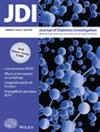Construction and validation of nomogram prediction model for ketoacidosis in elderly diabetic patients based on baseline data and glycolipid metabolism
Abstract
Objective
To explore the risk factors of ketoacidosis (DKA) in elderly patients with diabetes and to construct a nomogram prediction model to guide clinical practice.
Methods
Baseline, glycolipid metabolism, and related data were collected. Risk factors were screened by multifactor logistic regression analysis to construct a model. The effectiveness of the model was evaluated by Receiver Operating Characteristiv (ROC) curve, calibration curve analysis, and decision curve analysis (DCA).
Results
Logistic regression analysis showed that age, duration of diabetes, FBG, 2hPG, HbA1c, TG, TC, and C peptide level were the independent risk factors for DKA in elderly diabetic patients (P < 0.05). The nomogram prediction model constructed based on these factors showed good prediction performance in both the training set and the verification set, with the C-index indexes being 0.880 and 0.918, respectively, and the average absolute errors of coincidence between the predicted value and the true value being 0.102 and 0.075, respectively. The results of the Hosmer–Lemeshow test were χ2 = 12.750, P = 0.120 and χ2 = 8.325, P = 0.402, respectively. The ROC curve showed that the AUC of the nomogram model in the training set and the verification set for predicting the occurrence of DKA in elderly diabetic patients was 0.866 and 0.879, respectively.
Conclusion
Nomogram prediction model based on baseline data and glucose and lipid metabolism indicators showed good prediction efficiency in both the training set and the verification set. Age, diabetes duration, FBG, 2hPG, HbA1c, TG, TC, and C peptide levels were independent risk factors for DKA in elderly diabetic patients.


 求助内容:
求助内容: 应助结果提醒方式:
应助结果提醒方式:


